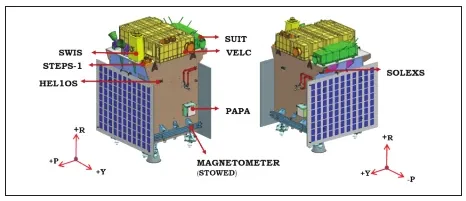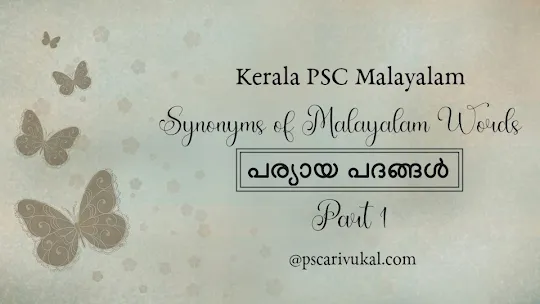Aditya-L1 is India's first space mission to study the Sun from a substantial distance of 1.5 million kilometers.
Aditya in Sanskrit means the Sun and L1 suffix in the mission's name refers to Lagrange Point 1 of the Sun-Earth system.
It will take approximately 125 days to reach the L1 point. This placement enables Aditya-L1 to continuously view the Sun without any occultation/eclipse.
The Indian Space Research Organisation (ISRO) launched Aditya-L1, a solar observatory, on September 2, 2023. After AstroSat (2015), it is ISRO's second astronomy observatory-class mission.
According to ISRO, the Aditya-L1 Mission's distinctive feature is its onboard intelligence for detecting CMEs and solar flares for optimal observations and data volume.
Key facts:
- First Solar Mission of India.
- The 4th nation in the world to send a solar mission.
- Launched on – September 2, 2023.
- Launched from – Sriharikotta.
- Launch Vehicle – PSLV-XL/C-57.
- Designed and developed by – VSSC (TVM)
- Launched from – Satish Dhawan Space Centre, Sriharikota
- Weight – 1,475 Kg.
- Total Cost – ₹ 378 cr.
- Mission duration – 5.2 years (planned).
- ISRO Chairman – S. Somanath.
- Project Director – Nigar Shaji.
Objectives of Aditya L1 Mission
- To study the Sun's upper atmospheric (chromosphere and corona) dynamics.
- To study chromospheric and coronal heating, physics of the partially ionized plasma, initiation of the coronal mass ejections, and flares,
- To observe the magnetic field topology and magnetic field measurements in the solar corona
- To observe the in-situ particle and plasma environment providing data for the study of particle dynamics from the Sun.
- Diagnostics of the coronal and coronal loops plasma: Temperature, velocity and density.
- To understand the initiation of Coronal Mass Ejection (CME), solar flares, and near-earth space weather.
- To observe the origin, composition, and dynamics of solar wind.
Structure & Payloads of Aditya L1 Mission
Aditya L1 is a cube-shaped satellite with a honeycomb sandwich structure. Its main body is 2.9 feet x 2.9 feet x 2 feet and it weighs 1,475 kg.
The Aditya-L1 started its journey in a folded configuration. When fully extended, the spaceship will have two wings with two solar panels measuring 3.9 feet × 2.7 feet each. These will help the spacecraft's lithium-ion battery give power to Aditya-L1.
The craft's position will be tracked using a small GPS sensor, which will give position, velocity, and time data in real-time.
It was assembled at the U.R. Rao Satellite Centre (URSC) in Bengaluru.
Payloads
The Aditya-L1 craft has a payload of 7 scientific instruments, each with distinct functions, which weigh around 244 kg) and will be carried on the spacecraft's top deck.
The payloads are as follows:
| Type | Payload | Capability |
|---|---|---|
| Remote Sensing Payloads | Visible Emission Line Coronagraph(VELC) | Corona/Imaging & Spectroscopy |
| Solar Ultraviolet Imaging Telescope (SUIT) | Photosphere and Chromosphere Imaging- Narrow & Broadband | |
| Solar Low Energy X-ray Spectrometer (SoLEXS) | Soft X-ray spectrometer: Sun-as-a-star observation | |
| High Energy L1 Orbiting X-ray Spectrometer(HEL1OS) | Hard X-ray spectrometer: Sun-as-a-star observation | |
| In-situ Payloads | Aditya Solar Wind Particle Experiment(ASPEX) | Solar wind/Particle Analyzer Protons and heavier Ions with directions |
| Plasma Analyser Package For Aditya (PAPA) | Solar wind/Particle Analyzer Electrons and heavier Ions with directions | |
| Advanced Tri-axial High-Resolution Digital Magnetometers | In-situ magnetic field (Bx, By and Bz). |
Aditya-L1 & Kerala
As India's first solar exploration satellite entered orbit was a proud moment for Kerala too. The four of Kerala's public sector undertakings include:
- Keltron
- Kerala Automobiles Ltd (KAL)
- Travancore Cochin Chemicals (TCC)
- Steel and Industrial Forgings Limited (SIFL)
have contributed to this achievement. The 38 electronic modules used in the PSLV-C57 launch vehicle were manufactured by Keltron.
The various forgings and components for the launch vehicle's propellor tank, engine, and rocket body were also created in-house by the SIFL and TCC and KAL contributed several components for the rocket's satellite separation mechanism.
International Solar Missions
Some of the major solar missions around the world is listed below:
| Year | Mission | Space Agency |
|---|---|---|
| 1965-1983 | Pioneer 6, 7, 8, 9 | NASA |
| 1970 | Helios 1 & 2 | NASA & DLR |
| 1978 | ISEE-3 | NASA |
| 1995 | SOHO | European Space Agency (ESA) & NASA |
| 1991 | Yohkoh | ISAS |
| 1994 | Ulysses | NASA |
| 2006 | Hinode (Solar B) | ISAS |
| 2006 | Solar Terrestrial Relations Observatory (STEREO) | NASA |
| 2010 | SDO | NASA |
| 2013 | Interface Region Imaging Spectrograph (IRIS) | NASA |
| 2018 | Parker Solar Probe | NASA |
| 2020 | Solar Orbiter | NASA |
📝SideNotes:
- Lagrange points – They are special positions in space where the gravitational forces of two large orbiting bodies, such as the Sun and the Earth, balance each other out.
- There are a total of five Lagrange points in the sun-earth system namely L1, L2, L3, L4 & L5.
- The first-ever mission to "touch" the Sun – Parker Solar Probe (NASA, launched in 2018).
- DLR is the space agency of – Germany.
- ISAS (Institute of Space and Astronautical Science) is the space agency of – Japan.
- Union Minister of State for Science and Technology – Dr. Jitendra Singh.
- Chairman of ISRO – S. Somanath.
- S. Somanath – Sreedhara Panicker Somanath.
- 10th ISRO Chairman.
- 5th Malayali ISRO Chairman.
- Secretary of Department of Space.
- Ex-officio chairman of both the Space Commission
- Belong to – Thuravoor, Alappuzha.
- Served as –
- Director of Vikram Sarabhai Space Centre (2018-2022).
- Director of Liquid Propulsion Systems Centre (2015-2018).
- Malayali ISRO Chairmans so far – (5)
- MGK Menon (1972), K. Kasthurirangan (1994-2003), G. Madhavan Nair (2003-2009), K. Radhakrishnan (2009-2014), S. Somanath (2022).
Thanks for reading!!!










Post a Comment
Post a Comment